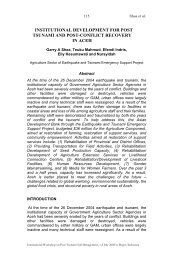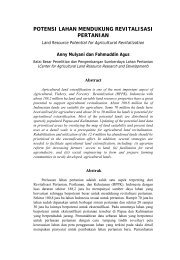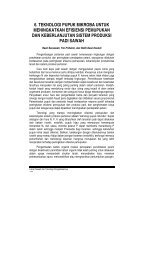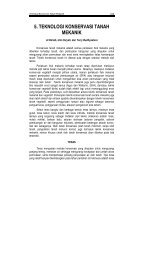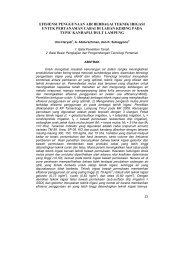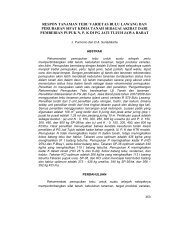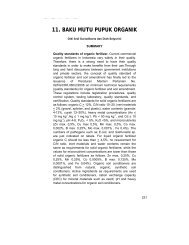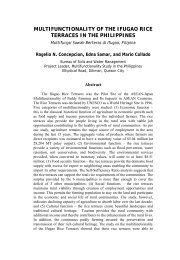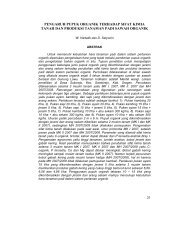Proceedings - Balai Penelitian Tanah
Proceedings - Balai Penelitian Tanah
Proceedings - Balai Penelitian Tanah
Create successful ePaper yourself
Turn your PDF publications into a flip-book with our unique Google optimized e-Paper software.
93<br />
Joshi L<br />
The survey conducted in 2007 in the three locations in Aceh and Nias<br />
also produced a list of ‘tree species local people want’ (Table 4). Tree<br />
crops, particularly rubber and cocoa, were the most preferred except<br />
in Pidie. Pandanus species used for handicrafts is more wanted by<br />
local people in the coastal area in Pidie. Annual crops seem important<br />
only in the coastal area of West Aceh. The findings are not surprising<br />
and are consistent with the contribution of these to overall income<br />
sources (Table 2).<br />
Table 4. Tree species people want (% respondents)<br />
Coastal area Inland area<br />
W Aceh Pidie Nias W Aceh Pidie Nias<br />
Tree crops 61.3 52 66.7 93.8 90 65.7<br />
Clonal rubber 45.2 57.6 59.4 51.4<br />
Cocoa 6.5 9.1 31.3 77.4 14.3<br />
Coconut 6.5 13.8<br />
Oil palm 3.2 3.1 3.2<br />
Areca nut 9.7<br />
Pandanus 37.9<br />
Timber trees 3.2 3.4 24.2 34.3<br />
Fruit trees 6.9 3.2<br />
Annual crops 22.6 3.4 3.1 6.5<br />
No interest 12.9 34.5 9.1 3.1<br />
Source: Budidarsono et al. 2007.<br />
PRESSURE ON NATURAL RESOURCES<br />
During the ‘construction boom’ phase (for about 3 years following the<br />
Tsunami), the high demand for construction materials (sand, stone,<br />
timber and brick) has led to intensified logging and sand/rock mining<br />
activities throughout Aceh and Nias. Reconstruction works, mainly in<br />
the coastal areas, in Aceh have already used an estimated 850,000<br />
cubic meters of illegal logs (nearly 50% of the total timber used). It is<br />
estimated that illegal logging is destroying around 20,769 ha of rain<br />
forest each year in Aceh. Most of this is in the inland areas that had<br />
remained relatively intact during the conflict years. The deforestation<br />
sharply intensified after the earthquake and Tsunami. The price of rice<br />
doubled within a year after the Tsunami, leading to clearance of more<br />
land for growing rice. The clearance of peat area for human<br />
settlements and oil palm plantations is also an environmental problem.<br />
ReGrIn PROJECT<br />
Given the importance of tree crops for both economic and<br />
environmental development in Aceh and Nias, in 2006 ICRAF and<br />
partners initiated a project Rebuilding Green Infrastructure with<br />
International Workshop on Post Tsunami Soil Management, 1-2 July 2008 in Bogor, Indonesia



